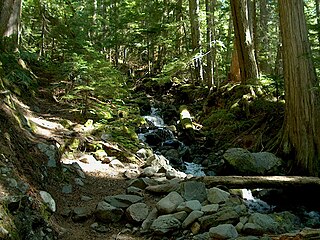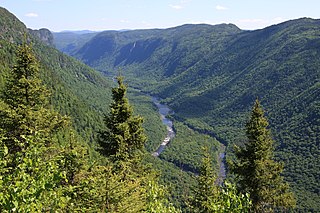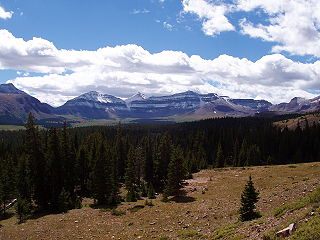
British Columbia mainland coastal forests is a temperate coniferous forest ecoregion the Pacific coast of North America, as defined by the World Wildlife Fund (WWF) categorization system.

The Rocky Mountain ponderosa pine forest is a forest plant community at an elevation of 2,100–2,700 metres (6,900–8,900 ft) in the Rocky Mountains, in the U.S. state of Colorado. It is an important temperate coniferous forest ecoregion, including some endemic wildlife and grass species that are only found in this ponderosa pine habitat.

The Cascade Mountains leeward forests are a temperate coniferous forest ecoregion of North America, as defined by the World Wildlife Fund (WWF) categorization system.

The eastern forest–boreal transition is a temperate broadleaf and mixed forests ecoregion of North America, mostly in eastern Canada. It is a transitional zone or region between the predominantly coniferous Boreal Forest and the mostly deciduous broadleaf forest region further south.
The Gulf of St. Lawrence lowland forests are a temperate broadleaf and mixed forest ecoregion of eastern Canada.

The Alberta Mountain forests are a temperate coniferous forests ecoregion of Canada.

The Alberta–British Columbia foothills forests are a temperate coniferous forests ecoregion of Canada. This ecoregion borders Canada's taiga and contains a mix of subarctic forest and temperate forest species as a result. This makes the region an ecotone region, or a region that acts as a buffer between two other biomes.
The Yukon Interior dry forests is a taiga ecoregion of Canada.
The Muskwa-Slave Lake forests is a taiga ecoregion in Canada.

The South Central Rockies forests is a temperate coniferous forest ecoregion of the United States located mainly in Wyoming, Idaho, and Montana. It has a considerably drier climate than the North Central Rockies forest.

The Colorado Rockies forests is a temperate coniferous forest ecoregion of the United States.

The Wasatch and Uinta montane forest is a temperate coniferous forest ecoregion in the Wasatch Range and Uinta Mountains of the western Rocky Mountains system, in the Western United States.
The Mid-Continental Canadian forests are a taiga ecoregion of northern Canada.
The Midwestern Canadian Shield forests ecoregion, in the Taiga and Boreal forests Biome, are of northern Canada.

The Central Canadian Shield forests are a taiga ecoregion of Canada.

The upper montane forest is a vegetation type generally found above the mixed coniferous forest and below the subalpine forest vegetation types. Most of what grows in upper montane forests are conifers, because of the short growing season.

The Fraser Biosphere Reserve and Experimental Forest is a former UNESCO Biosphere Reserve situated on the west side of the Continental Divide in north-central Colorado and includes the entire watershed of Main St. Louis Creek, a tributary of the Fraser River.

Waterton Biosphere Reserve is a UNESCO Biosphere Reserve encompassing Waterton Lakes National Park in the extreme south-west of the Province of Alberta, Canada. The reserve includes a section of the east slopes of the Rocky Mountains extending from the Continental Divide to the edge of the Canadian Great Plains to the east. The Glacier Biosphere Reserve and National Park in Montana, USA is located to the south of the area. The reserve is administered by Waterton Lakes National Park and the Waterton Biosphere Association.














